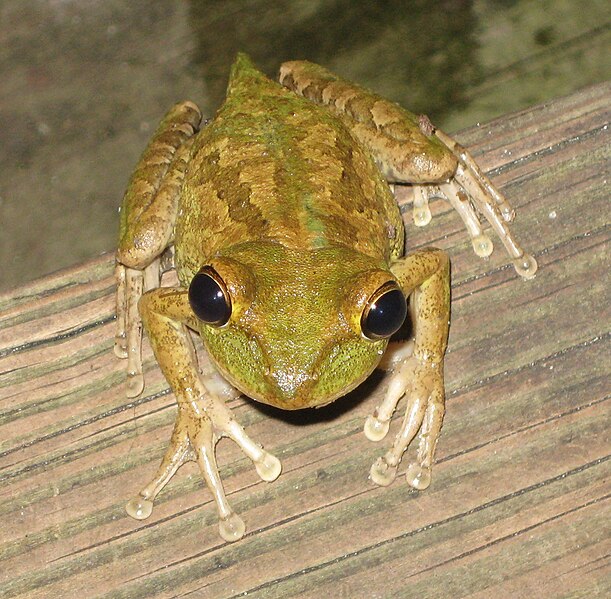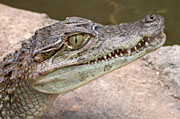 Many interesting amphibian and reptile field research reports are published in professional journals such as Copeia, Herpetologica and Herpetological Review, and are not available on the internet. Unfortunately, such journals are usually quite expensive (if well-worth the price). From time to time I’ll provide summaries of interesting articles that I come across. Today’s report is drawn from Autumn, 2010 publications and covers 2 unusual feeding records. The observations were made in Florida and, as might be expected, both predator and prey (Cuban Treefrog, Spectacled Caiman, Walking Catfish) were non native species!
Many interesting amphibian and reptile field research reports are published in professional journals such as Copeia, Herpetologica and Herpetological Review, and are not available on the internet. Unfortunately, such journals are usually quite expensive (if well-worth the price). From time to time I’ll provide summaries of interesting articles that I come across. Today’s report is drawn from Autumn, 2010 publications and covers 2 unusual feeding records. The observations were made in Florida and, as might be expected, both predator and prey (Cuban Treefrog, Spectacled Caiman, Walking Catfish) were non native species!
Cuban Treefrog, Osteopilus septentrionalis
Cuban Treefrogs are large as treefrogs go, and will tackle anything that might (or might not!) fit into their cavernous jaws. I released several in a greenhouse at the Bronx Zoo, and was once startled to find one swallowing a Green Anole that exceeded itself in length. But an observation made recently in Florida put my own to shame.
Cuban Treefrogs, native to Cuba, the Cayman Islands and the Bahamas, are well established in Florida. In Jupiter, Florida, a 2.4 inch-long Cuban Treefrog was found (on a sidewalk, no less!) with a Ringneck Snake (Diadophis punctatus) measuring over 7 inches in length protruding from it’s mouth. The frog was unable to completely swallow the snake, but held onto it for 40 minutes, after which the observer took a photo and departed.
Spectacled Caiman, Caiman crocodylus
 Spectacled Caiman have been recorded in 7 US states but are breeding only in Florida. Southeast Asia’s Walking Catfish (Clarius batrachus) has been established in Florida since the 1960’s, when a number apparently “walked” away from fish dealers there. While visiting a turtle breeder in the state several years ago, I was astonished to see scores of Walking Catfishes surface for the trout chow he tossed into his outdoor turtle ponds. They are most interesting, but have played havoc with South Florida’s aquatic ecosystems.
Spectacled Caiman have been recorded in 7 US states but are breeding only in Florida. Southeast Asia’s Walking Catfish (Clarius batrachus) has been established in Florida since the 1960’s, when a number apparently “walked” away from fish dealers there. While visiting a turtle breeder in the state several years ago, I was astonished to see scores of Walking Catfishes surface for the trout chow he tossed into his outdoor turtle ponds. They are most interesting, but have played havoc with South Florida’s aquatic ecosystems.
But they have enemies…a Spectacled Caiman that appeared ill was collected in the Everglades National Park. It died soon after, and upon autopsy an adult Walking Catfish was found lodged in its throat. The feisty beast had flared both of its sharp pectoral fins, and each had pierced the Caiman’s esophagus. Based on my observations of many types of catfishes (the group is a great favorite of mine), I can imagine that similar fates have befallen a number of other species.
 In reading some related articles I learned that catfish-related deaths have been reported in quite large animals. In Puerto Rico, at least 20 Brown Pelicans have been killed by non-native Sailfin Catfishes.
In reading some related articles I learned that catfish-related deaths have been reported in quite large animals. In Puerto Rico, at least 20 Brown Pelicans have been killed by non-native Sailfin Catfishes.
Further Reading
Natural History of Spectacled Caimans in Florida
Natural History of Cuban Treefrogs in Florida
Spectacled Caiman image referenced from wikipedia and originally posted by Curtis Clark
 That Reptile Blog – Reptile, Amphibian and Exotic Pet Care and Information
That Reptile Blog – Reptile, Amphibian and Exotic Pet Care and Information



Hey Frank–is the report of the Cuban Treefrog eating a ringneck available online, or has it been published in Herp Review yet?
Never mind–I see that you found it in Fall 2010 issue. Pls disregard my question.
Do you still have the picture of the Cuban treefrog eating a ringneck?
Hello Rachel
Thanks for your interest.
Unfortunately, the photo was published in Herpetological Review and is not posted on line. This article has a shot of one consuming a Green Treefrog and some great info.
Please let me know if you need any further information. Good luck, enjoy and please keep me posted.
Best regards, Frank Indiviglio.
Thanks for the response. I used the picture for my invasive species speech in my technical presentations class.
Hello Rachel
My pleasure, glad it was useful.
Please let me know if you need any further information. Good luck, enjoy and please keep me posted.
Best regards, Frank Indiviglio.
Thanks for the article Frank. Living here in Fla It is amazing how many non natives are now making Fla home
Thanks for your interest….at least 50 reptiles/amphibs established (breeding) and amazing numbers of birds, fish, inverts and mammals (i.e. capybaras!); if you’ve not seen it, this site should interest you.
Enjoy,. Frank